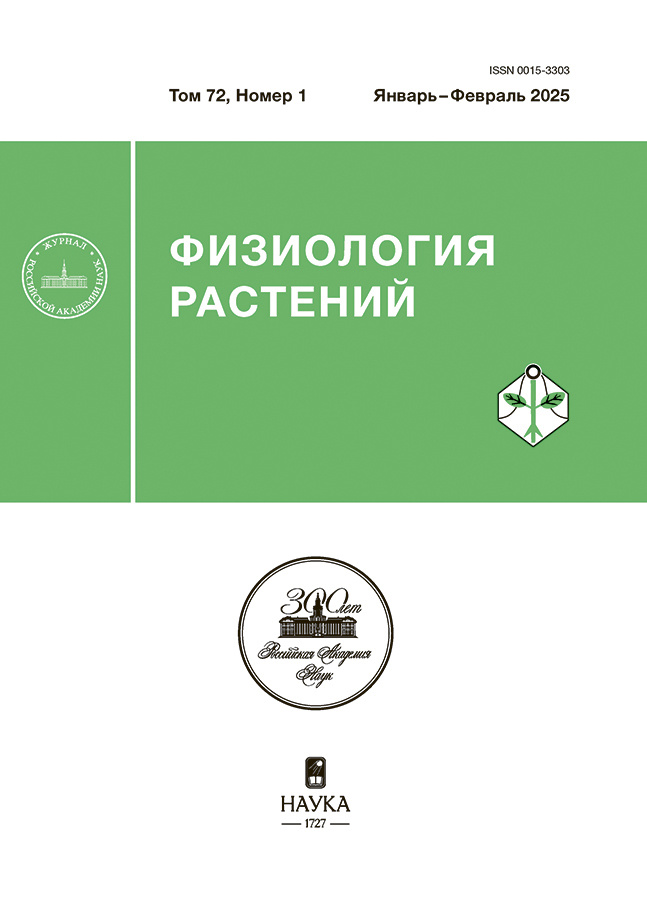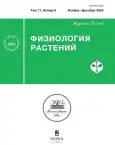Особенности роста и развития пыльцевых трубок ели (Picea abies (L.) Karst. × P. obovata Ledeb.) in vitro
- Authors: Сурсо М.В.1
-
Affiliations:
- Федеральный исследовательский центр комплексного изучения Арктики им. академика Н.П. Лаверова Уральского отделения Российской академии наук
- Issue: Vol 71, No 6 (2024)
- Pages: 810-819
- Section: ЭКСПЕРИМЕНТАЛЬНЫЕ СТАТЬИ
- URL: https://gynecology.orscience.ru/0015-3303/article/view/648271
- DOI: https://doi.org/10.31857/S0015330324060146
- EDN: https://elibrary.ru/LVXCJL
- ID: 648271
Cite item
Abstract
Изучено влияние состава сахаров и pH питательной среды на рост и развитие пыльцевых трубок у интрогрессивного гибрида ели европейской и сибирской (Picea abies (L.) Karst. × P. obovata Ledeb.) in vitro. Показана динамика роста пыльцевых трубок ели. Установлено, что относительно высокая скорость роста пыльцевых трубок во многом обуславливает особенности физиологии их развития. Описана картина быстрого синтеза целлюлозы в процессе гидратации пыльцевых зерен ели. Выявлены различия компонентного состава пыльцы и пыльцевых трубок. Содержание белков, аминокислот, РНК, ДНК, липидов и полисахаридов по градиенту длины пыльцевых трубок у ели возрастали скачкообразно по направлению к растущему кончику и стабилизировались по достижении примерно половины их максимальной длины. При этом общее содержание углеводов в пыльцевых трубках по градиенту длины практически не изменялось. Описаны процессы формирования на поверхности пыльцевых трубок внешних колец, состоящих в основном из целлюлозы и каллозы. Высказано предположение, что такие кольца могут участвовать в регулировании тургора и в частичной компартментализации протопласта в пыльцевых трубках ели. Каллозу в пыльцевых трубках у ели следует рассматривать как ситуативный антистрессовый полисахарид, который не является постоянным компонентом стенки трубки.
Keywords
Full Text
About the authors
М. В. Сурсо
Федеральный исследовательский центр комплексного изучения Арктики им. академика Н.П. Лаверова Уральского отделения Российской академии наук
Author for correspondence.
Email: surso@fciarctic.ru
Russian Federation, Архангельск
References
- Fernando D.D., Quinn Ch.R, Brenner E.D., Owens J.N. Male gametophyte development and evolution in extant Gymnosperms // Int. J. Plant Dev. Biol. 2010. V. 4. P. 47.
- Breygina M., Klimenko E., Schekaleva O. Pollen germination and pollen tube growth in Gymnosperms // Plants. 2021. V. 10. P. 1301. https://doi.org/10.3390/plants10071301
- Derksen J., Li Y.-Q., Knuiman B., Geurts H. The wall of Pinus sylvestris L. pollen tubes // Protoplasma. 1999. V. 208. P. 26. https://doi.org/10.1007/BF01279072
- Mollet J.-C., Leroux C., Dardelle F., Lehner A. Cell wall composition, biosynthesis and remodeling during pollen tube growth // Plants. 2013. V. 2. P. 107. https://doi.org/10.3390/plants2010107
- Justus C.D., Anderhag P., Goins J.L., Lazzaro M.D. Microtubules and microfilaments coordinate to direct a fountain streaming pattern in elongating conifer pollen tube tips // Planta. 2004. V. 219. P. 103. https://doi.org/10.1007/s00425-003-1193-2
- Chebli Y., Kroeger J., Geitmann A. Transport logistics in pollen tubes // Mol. Plant. 2013. V. 6. P. 1037. https://doi.org/10.1093/mp/sst073
- Li G.-P., Huang Q.-C., Yang L.-S., Qin G.-Y. In vitro pollen germination and pollen tube growth of Pinus thunbergii // Forest Research. 2007. V. 20. P. 224.
- Krichevsky A., Kozlovsky S.V., Tian G.W., Chen M.H., Zaltsman A., Citovsky V. How pollen tubes grow // Dev. Biol. 2007. V. 303. P. 405. https://doi.org/10.1016/j.ydbio.2006.12.003
- Williams J.H., Edwards J.A., Ramsey A.J. Economy, efficiency, and the evolution of pollen tube growth rates // Am. J. Bot. 2016. V. 103. P. 471. https://doi.org/10.3732/ajb.1500264
- Schlüpmann H., Bacic A., Read S.M. Uridine-diphosphate glucose metabolism and callose synthesis in cultured pollen tubes of Nicotiana alata Link et Otto // Plant Physiol. 1994. V. 105. P. 659. https://doi.org/10.1104/pp.105.2.659
- Ferguson C., Teeri T.T., Siika-aho M., Read S.M., Bacic A. Location of cellulose and callose in pollen tubes and grains of Nicotiana tabacum // Planta. 1998. V. 206. P. 452. https://doi.org/10.1007/s004250050421
- Chebli Y., Kaneda M., Zerzour R., Geitmann A. The cell wall of the Arabidopsis pollen tube – spatial distribution, recycling, and network formation of polysaccharides // Plant Physiol. 2012. V. 160. P. 1940. https://doi.org/10.1104/pp.112.199729
- Mogami N., Miyamoto M., Onozuka M., Nakamura N. Comparison of callose plug structure between dicotyledon and monocotyledon pollen germinated in vitro // Grana. 2006. V. 45. P. 249. https://doi.org/10.1080/00173130600726687
- Nishikawa S., Zinkl G.M., Swanson R.J., Maruyama D., Preuss D. Callose (β-1,3 glucan) is essential for Arabidopsis pollen wall patterning, but not tube growth // BMC Plant Biol. 2005. V. 5. P. 22. https://doi.org/10.1186/1471-2229-5-22
- Li Y.-Q., Moscatelli A., Cai G., Cresti M. Functional interactions among cytoskeleton, membranes, and cell wall in the pollen tube of flowering plants // Int. Rev. Cyt. 1997. P. 133. https://doi.org/10.1016/s0074-7696(08)61610-1
- Parre E., Geitmann A. More than a leak sealant. The mechanical properties of callose in pollen tubes // Plant Physiol. 2005. V. 137. P. 274. https://doi.org/10.1104/pp.104.050773
- Williams J.H. Novelties of the flowering plant pollen tube underlie diversification of a key life history stage // Proc. Natl. Acad. Sci. U.S.A. 2008. V. 105. P. 11259. https://doi.org/10.1073/pnas.0800036105
- Yatomi R., Nakamura S., Nakamura N. Immunochemical and cytochemical detection of wall components of germinated pollen of Gymnosperms // Grana. 2002. V. 41. P. 21. https://doi.org/10.1080/00173130260045468
- Chen T., Wu X., Chen Y., Li X., Huang M., Zheng M., Baluška F., Šamaj J., Lin J. Combined proteomic and cytological analysis of Ca2+-calmodulin regulation in Picea meyeri pollen tube growth // Plant Physiol. 2009. V. 149. P. 1111. https://doi.org/10.1104/pp.108.127514
- Chichiriccò G., Spanò L., Torraca G., Tartarini A. Hydration, sporoderm breaking and germination of Cupressus arizonica pollen // Plant Biol. 2009. V. 11. P. 359. https://doi.org/10.1111/j.1438-8677.2008.00134.x
- Pacini E., Franchi G.G., Ripaccioli M. Ripe pollen structure and histochemistry of some Gymnosperms // Plant Syst. Evol. 1999. V. 217. P. 81. https://doi.org/10.1007/BF00984923
- Parrotta L., Faleri C., Del Casino C., Mareri L., Aloisi I., Guerriero G. Biochemical and cytological interactions between callose synthase and microtubules in the tobacco pollen tube // Plant Cell Rep. 2022. V. 41. P. 1301. https://doi.org/10.1007/s00299-022-02860-3
- Правдин Л.Ф. Ель европейская и ель сибирская в СССР. М.: Наука, 1975. 200 с.
- Белик А.А., Зуева А.О. Выделение, свойства и аминокислотные последовательности двух 1,3-β-D-глюконаз брюхоногого моллюска Lambis sp. // Вестник ДВО РАН. 2018. № 2. С. 159.
- Cao Y., Hao R.-Z., Liu M.-Q., An X.-M., Jing Y.-P. Distribution of nuclei and microfilaments during pollen germination in Populus tomentosa Carr. // Afr. J. Agric. Res. 2012. V. 7. P. 2679.
- Singh H. Embryology of Gymnosperms. Berl.-Stuttg.: Gerb. Borntraeger, 1978. 304 p.
- Козубов Г.М., Тренин В.В., Тихова М.А., Кондратьева В.П. Репродуктивные структуры голосеменных (сравнительное описание). Ленинград: Наука, 1982. 104 с.
- Tushabe D., Rosbakh S. A compendium of in vitro germination media for pollen research // Front. Plant Sci. 2021. V. 12: 709945.
- Sede A.R., Wengier D.L., Borassi C., Estevez J.M., Muschietti J.P. Imaging and analysis of the content of callose, pectin, and cellulose in the cell wall of Arabidopsis pollen tubes grown in vitro // Pollen and pollen tube biology: methods and protocols / Ed. A. Geitmann. Publisher: Humana. 2020. P. 242. https://doi.org/10.1007/978-1-0716-0672-8
- Schmucher T. Bor als physiologisch entscheidendes element // Naturwiss. 1932. № 20. S. 839. https://doi.org/10.1007/BF01494925
- Stanley R.G., Linskens H.F. Pollen (biology, biochemistry, management). Berlin, Heidenberg, N.Y.: Spring-Verlag. 1974. 307 p.
- Wang Q.L., Lu L.D., Wu X.Q., Li Y.Q., Lin J.X. Boron influences pollen germination and pollen tube growth in Picea meyeri // Tree Physiol. 2003. V. 23. P. 345. https://doi.org/10.1093/treephys/23.5.345
- Korkmaz N., Guneri M. Effect of different boron levels on pollen germination of hicaznar pomegranate (Punica granatum L.) cultivar // Int. J. Agric. Life Sci. 2019. V. 3. P. 151.
- Castillo S.E., Tovar J.C., Shamin A., Gutirerrez J., Pearson P., Gehan M.A. A protocol for Chenopodium quinoa pollen germination // Plant Methods. 2022. V. 18: 65. https://doi.org/10.1186/s13007-022-00900-3
- Zhou J., Fan C., Liu K., Jing Y. Extracellular ATP is involved in the initiation of pollen germination and tube growth in Picea meyeri // Trees. 2015. V. 29. P. 563. https://doi.org/10.1007/s00468-014-1135-6
- Dutta R., Sahai P., Kenneth R., Robinson K.R. Mechanisms involved in pollen tube growth: a review // Plant Cell Biotechnol. Mol. Biol. 2021. V. 22. P. 191. https://ikprress.org/index.php/PCBMB/article/view/7216
- Горячкина О.В., Седаева М.И. Морфология и качество пыльцы у видов рода Picea (Pinaceae) из коллекции дендрария Института леса им. В.Н. Сукачева СО РАН // Растительный мир Азиатской России. 2012. № 2(10). С. 27.
- Breygina M., Maksimov N., Polevova S., Evmenyeva A. Bipolar pollen germination in blue spruce (Picea pungens) // Protoplasma. 2019. V. 256. P. 941. https://doi.org/10.1007/s00709-018-01333-3
- Dawkins M.D., Owens J.N. In vitro and in vivo pollen hydration, germination, and pollen-tube growth in white spruce, Picea glauca (Moench) Voss. // Int. J. Plant Sci. 1993. V. 154. P. 506.
- Surso M.V., Chuhchinb D.G., Khviyuzov S.S., Pokryishkin S.A. Mechanism of pollen germination and pollen tubes growth in common juniper (Juniperus communis L.) in vitro // Russ. J. Dev. Biol. 2020. V. 51. P. 294. https://doi.org/10.1134/S1062360420050070
Supplementary files















